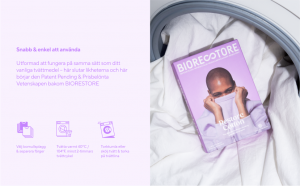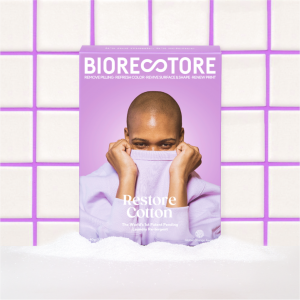Stockholm, Sweden Jul 4, 2024 (Issuewire.com) - Ever noticed the small, pesky little balls of fabric appearing on the surface of your clothing? That’s fabric pilling! A common enemy for your clothes is making them look dull and worn-out only after a few wears and laundry cycles. But why does it happen? And how can you prevent it?
In this blog, we will tell you everything you need to know about fabric pilling and its removal methods. Let’s get started!
What is pilling?
Clothes are made of fibrous textile yarns, which face a daily round of physical stresses.
When we wear a piece of clothing or wash it in the laundry machine, it faces excessive stress and friction, which can break some of the textile fibres or cause the smooth surface to roughen over time. After some time, these loose fibres snag and tangle with each other, forming little fabric balls known as "pilling.” across the surface of the clothing textiles
Unfortunately, there is not a simple or definite way of knowing how much a fabric can pill. Generally, short staple (length) textile fibres (cotton, wool, rayon, acrylic, fleece, etc.) are more prone to pilling due to their increased likelihood of breaking, entanglement, and shedding. On the other hand, longer textile fibres (silk, cashmere, linen, Tencel, etc.) have greater inherent strength and smooth surfaces, making them less prone to pilling and bobbling.
What causes fabric pilling?
Fabric pilling occurs when there is excessive friction, shorter fibers, loosely spun yarns, and frequent washing or drying. This is why areas of high wear-and-tear, such as elbows, knees, cuffs, collars, seams, underarms, and areas across the sides of the body and chest etc., get more pilling as compared to other areas of the clothing as they are constantly rubbed against the body.
When it comes to natural fibres such as cotton, there is a secret weapon you can use to easily remove pilling in the washing machine by using BIORESTORE Re-Tergent. However, synthetics (polyester, acrylic) fibres are resistant to BIORESTORE, meaning the pilling and lint will not be removed with this method.
How to remove pilling (without ruining your clothes!)
There is no one-size-fits-all approach when it comes to wardrobe maintenance. Each fabric has a different composition and, hence, requires a little different TLC. Here’s how you can remove pilling from different types of clothing without damaging the textile fibre even more.
Remove pilling from cotton clothes.
Cotton makes upto 70% of our wardrobe. While it is comfy and breathable, it is also highly prone to lint, pilling, and bobbling.
BEST CHOICE: Using a Re-Tergent such as BIORESTORE is the most effective and easy-to-use method to restore the original colour, texture, and handfeel of your cotton clothing.
- Add 6–8 items of cotton clothing to the laundry machine.
- Put a box of BIORESTORE laundry powder directly in the washer.
- Run a 40ºC/104ºF cycle on cotton or eco mode for 2 hours.
- Tumble dry or rinse the clothes with a little detergent.
Synthetics
Synthetics, including polyester and acrylic, are notorious for pilling. Using a fabric shaver with a sharp blade should do the trick. However, it’s important to always stay cautious while using a fabric shaver, as it uses a high-speed blade that can cut through fabric and make holes within seconds.
Also, keep in mind to thoroughly clean the fabric shaver once you are done removing fabric pills from the garment. It will help in increasing the efficiency of the gadget, resulting in optimal performance.
Knitwear
For delicate knitwear which is made of loosely woven threads, which can snag and tear instantly. To remove pilling from knits or other delicate fabrics (silk or cashmere blends), you can use a sweater comb. In the case of deeply embedded bobbles, a fabric shaver can also be used, but in a low-power mode (fine-blade setting).
Word of Advice: When buying cashmeres, keep in mind that they will pill a lot (especially in the beginning). If you are not ready to indulge in pill removal sessions from time to time, it’s better to avoid cashmeres altogether (instead taking part in regular de-pilling sessions).
Expert tips to prevent pilling
Pilling is a natural process, but with some tips and tricks, you can limit the level of pilling on your clothing. Some of the best (and fact-checked) hacks are mentioned below.
Turn the clothes inside out
The strong ingredients in detergents combined with the centrifugal force of the washing machine take a toll on the fabric’s health, making it prone to rapid pilling. By turning your clothes inside out, you can avoid getting pills on the visible areas of the clothing.
Use a mild detergent
There is no need to use heavy-duty detergents to wash all of your clothing. While the surfactants in laundry powders are beneficial for removing dirt, debris, and unwanted odours, they can also cause fading and (quick) pilling in fabrics. For clothes hardly breaking any sweat, consider milder washing options (e.g., handwashing), or washing less frequently
Don’t overload the washing machine
It may seem like a time-saver, but adding an extra load to your laundry machine is the worst thing that you can do for your clothing. When each of the fabrics doesn’t get enough space to tumble around, the friction within the washer increases significantly, leading to excessive pilling and bobbling, as well as preventing thorough cleaning of your clothes.
Invest in high-quality clothing
We are all guilty of purchasing trending, low-quality clothing only because it comes within our desired price range. But fast fashion comes at a hidden cost: poor-quality fabrics that pill only after a few wears and laundry spins.
By investing in high-quality clothing, you can fill your wardrobe with timeless staples that can be cherished for a long time. Plus, they will pill a lot less (compared to low-quality clothing) and you will have to spend very little time maintaining your high-quality clothing.
Choose the right fabric pill remover
Not all fabrics are created equally, and the same goes for pill removers. While one solution might work great for your favourite cotton sweater, it could wreak havoc on a delicate silk blouse.
For example, BIORESTORE laundry powder is an excellent debobbler for clothing with at least 70% cotton composition. However, it might not be the best choice for other fabrics in your wardrobe such as wools, silks, or synthetics.
Similarly, while pilling razors are considered effective for high-density knits (like sweaters), they can cause permanent damage to loosely woven knits.
By having a little understanding of the kind of fabric you are dealing with, you can easily select the best way to remove pilling from them without causing any extra damage.
Happy laundry!
Media Contact
Biorestore AB hello@bio-restore.com 735003845 Gästrikegatan 14 113 56 Stockholm Sweden https://www.bio-restore.com/













